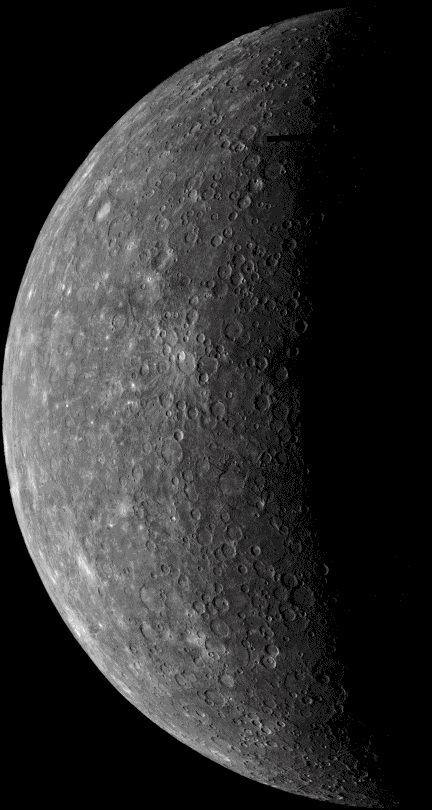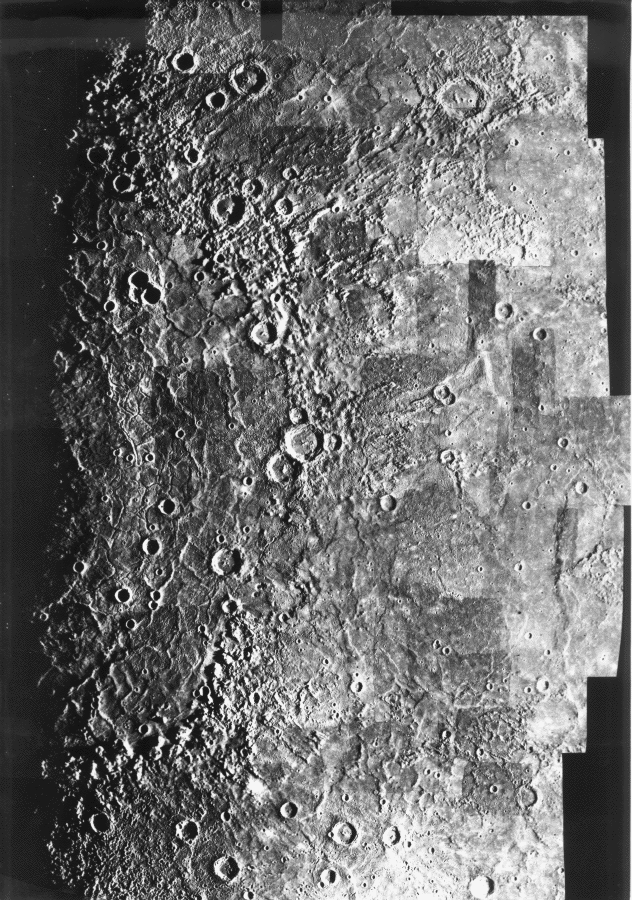
Mercury

Mercury is the closest planet to the Sun and the eighth largest.
orbit: 57,910,000 km (0.38 AU) from Sun
diameter: 4,880 km
mass: 3.30e23 kg
In Roman mythology Mercury is the god of commerce, travel and thievery, the Roman
counterpart of the Greek god Hermes, the messenger of the Gods. The planet probably
received this name because it moves so quickly across the sky. Mercury has been
known since at least the time of the Sumerians (3rd millennium BC). It was given two names
by the Greeks: Apollo for its apparition as a morning star and Hermes as an evening star.
Greek astronomers knew, however, that the two names referred to the same body. Heraclitus
even believed that Mercury and Venus orbit the Sun, not the Earth.
Mercury has been visited by only one spacecraft, Mariner 10. It flew by three times in
1974 and 1975. Only 45% of the surface was mapped (and, unfortunately, it is too close to
the Sun to be safely imaged by Hubble Space Telescope).
Mercury's orbit is highly eccentric; at perihelion it is only 46 million km from the Sun
but at aphelion it is 70 million. The perihelion of its orbit precesses around the Sun at
a very slow rate. 19th century astronomers made very careful observations of Mercury's
orbital parameters but could not adequately explain them using Newtonian mechanics. The
tiny differences between the observed and predicted values were a minor but nagging
problem for many decades. It was thought that another planet (sometimes called Vulcan)
might exist in an orbit near Mercury's to account for the discrepancy. The real answer
turned out to be much more dramatic: Einstein's General Theory of Relativity! Its correct
prediction of the motions of Mercury was an important factor in the early acceptance of
the theory.
Temperature variations on Mercury are the most extreme in the solar system ranging from 90
K to 700 K. The temperature on Venus is slightly hotter but very stable.
Mercury is in many ways similar to the Moon: its surface is heavily cratered and very old;
it has no plate tectonics. On the other hand, Mercury is much denser than the Moon (5.43
gm/cm3 vs 3.34). Mercury is the second densest major body in the solar system, after
Earth. Actually Earth's density is due in part to gravitational compression; if not for
this, Mercury would be denser than Earth. This indicates that Mercury's dense iron core is
relatively larger than Earth's, probably comprising the majority of the planet. Mercury
therefore has only a relatively thin silicate mantle and crust.
Mercury's interior is dominated by a large iron core whose radius is 1800 to 1900 km. The
silicate outer shell (analagous to Earth's mantle and crust) is only 500 to 600 km thick.
At least some of the core is probably molten.
Mercury actually has a very thin atmosphere consisting of atoms blasted off its surface by
the solar wind. Because Mercury is so hot, these atoms quickly escape into space. Thus in
contrast to the Earth and Venus whose atmospheres are stable, Mercury's atmosphere is
constantly being replenished.
The surface of Mercury exhibits enormous escarpments, some up to hundreds of kilometers in
length and as much as three kilometers high. Some cut thru the rings of craters and other
features in such a way as to indicate that they were formed by compression. It is
estimated that the surface area of Mercury shrank by about 0.1% (or a decrease of about 1
km in the planet's radius). FYI see Geology, v. 26, p. 911 (1998), an article on shrinking
due to cooling and the formation of thrust fault escarpments on the surface of Mercury.

The image above shows the enormous Caloris Basin, which is one of the
largest features on Mercury's surface (about 1300 km in diametert). It is thought to
be similar to the large circular basins found on the moon. Probably formed by a giant
impact
early in Mercury's history, this basin was subsequently filled by lava flows. The nature
of the wrinkle ridges on its floor is arguable: some scientists claim tectonics
while others suggest they are due to volcanic flows escaping from fractures.
In addition to the heavily cratered terrain, Mercury also has regions of relatively smooth
plains. Some may be the result of ancient volcanic activity but some may be the result of
the deposition of ejecta from cratering impacts.
Amazingly, radar observations of Mercury's north pole (a region not mapped by Mariner 10)
show evidence of water ice in the protected shadows of some craters.
Mercury has a small magnetic field whose strength is about 1% of Earth's.
Mercury has no known satellites.